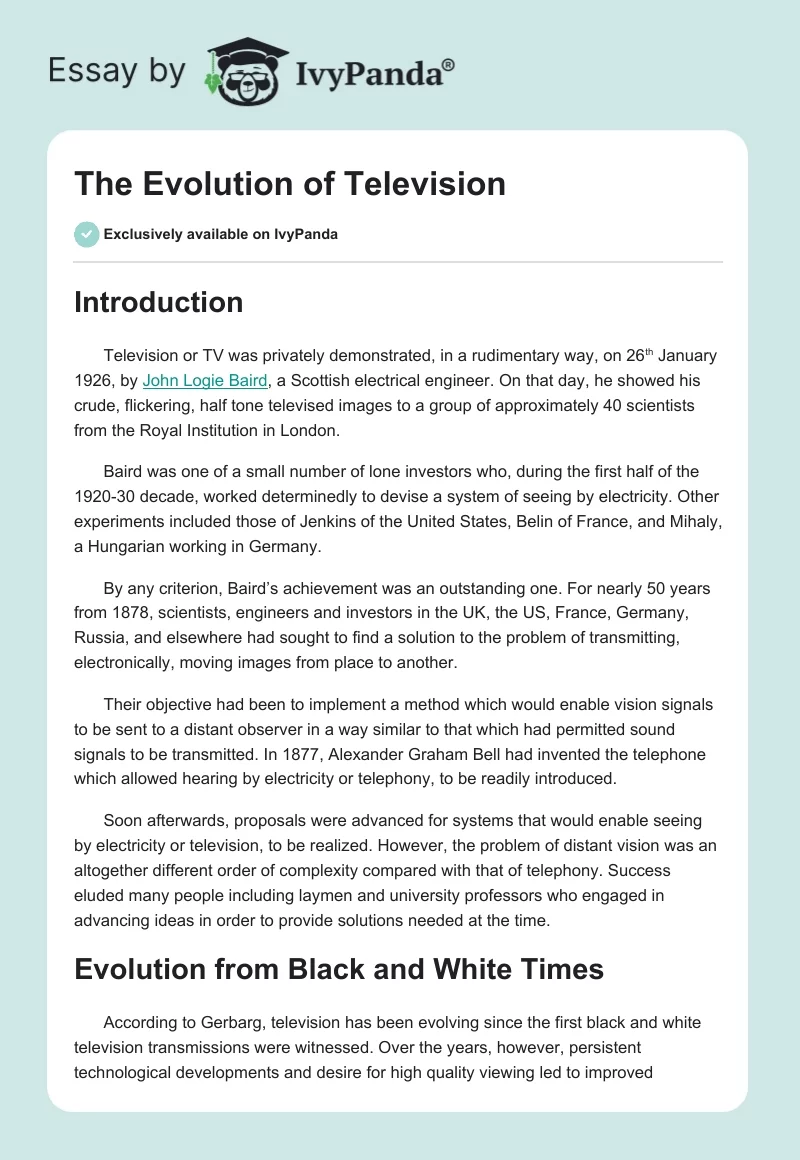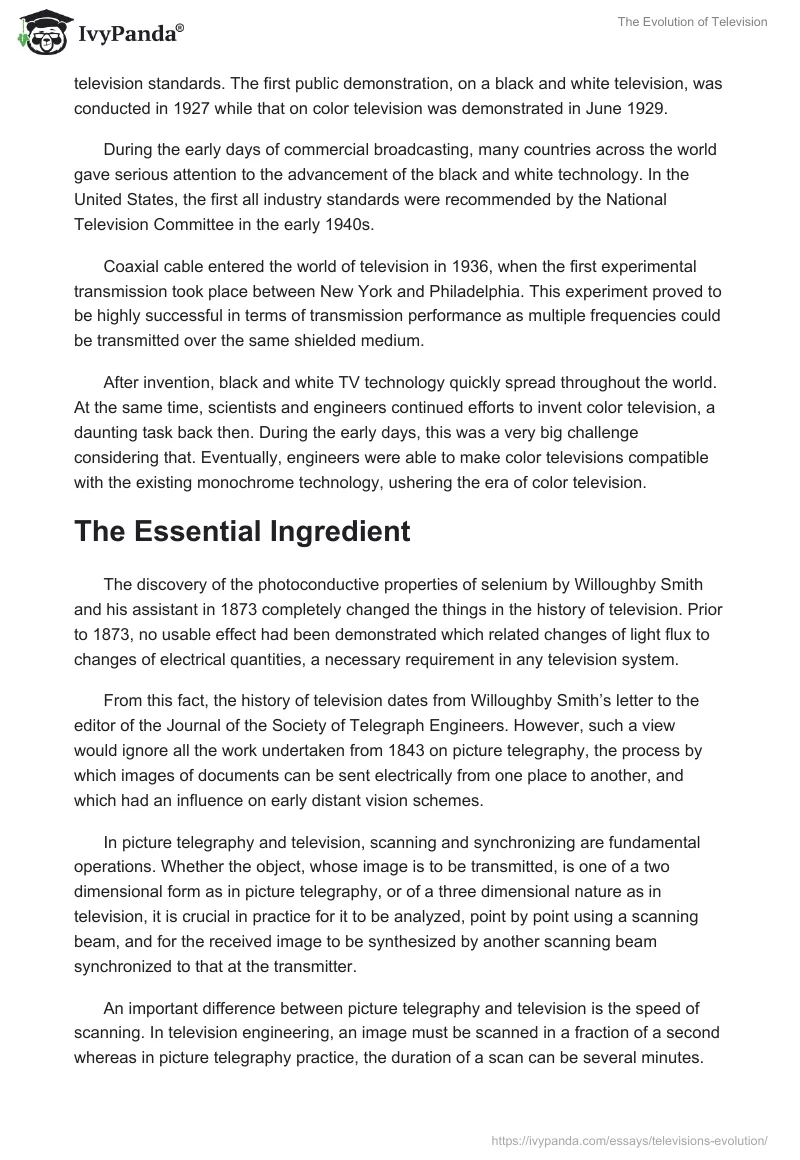Introduction
Television or TV was privately demonstrated, in a rudimentary way, on 26th January 1926, by John Logie Baird, a Scottish electrical engineer. On that day, he showed his crude, flickering, half tone televised images to a group of approximately 40 scientists from the Royal Institution in London.
Baird was one of a small number of lone investors who, during the first half of the 1920-30 decade, worked determinedly to devise a system of seeing by electricity. Other experiments included those of Jenkins of the United States, Belin of France, and Mihaly, a Hungarian working in Germany.
By any criterion, Baird’s achievement was an outstanding one. For nearly 50 years from 1878, scientists, engineers and investors in the UK, the US, France, Germany, Russia, and elsewhere had sought to find a solution to the problem of transmitting, electronically, moving images from place to another.
Their objective had been to implement a method which would enable vision signals to be sent to a distant observer in a way similar to that which had permitted sound signals to be transmitted. In 1877, Alexander Graham Bell had invented the telephone which allowed hearing by electricity or telephony, to be readily introduced.
Soon afterwards, proposals were advanced for systems that would enable seeing by electricity or television, to be realized. However, the problem of distant vision was an altogether different order of complexity compared with that of telephony. Success eluded many people including laymen and university professors who engaged in advancing ideas in order to provide solutions needed at the time.
Evolution from Black and White Times
According to Gerbarg, television has been evolving since the first black and white television transmissions were witnessed. Over the years, however, persistent technological developments and desire for high quality viewing led to improved television standards. The first public demonstration, on a black and white television, was conducted in 1927 while that on color television was demonstrated in June 1929.
During the early days of commercial broadcasting, many countries across the world gave serious attention to the advancement of the black and white technology. In the United States, the first all industry standards were recommended by the National Television Committee in the early 1940s.
Coaxial cable entered the world of television in 1936, when the first experimental transmission took place between New York and Philadelphia. This experiment proved to be highly successful in terms of transmission performance as multiple frequencies could be transmitted over the same shielded medium.
After invention, black and white TV technology quickly spread throughout the world. At the same time, scientists and engineers continued efforts to invent color television, a daunting task back then. During the early days, this was a very big challenge considering that. Eventually, engineers were able to make color televisions compatible with the existing monochrome technology, ushering the era of color television.
The Essential Ingredient
The discovery of the photoconductive properties of selenium by Willoughby Smith and his assistant in 1873 completely changed the things in the history of television. Prior to 1873, no usable effect had been demonstrated which related changes of light flux to changes of electrical quantities, a necessary requirement in any television system.
From this fact, the history of television dates from Willoughby Smith’s letter to the editor of the Journal of the Society of Telegraph Engineers. However, such a view would ignore all the work undertaken from 1843 on picture telegraphy, the process by which images of documents can be sent electrically from one place to another, and which had an influence on early distant vision schemes.
In picture telegraphy and television, scanning and synchronizing are fundamental operations. Whether the object, whose image is to be transmitted, is one of a two dimensional form as in picture telegraphy, or of a three dimensional nature as in television, it is crucial in practice for it to be analyzed, point by point using a scanning beam, and for the received image to be synthesized by another scanning beam synchronized to that at the transmitter.
An important difference between picture telegraphy and television is the speed of scanning. In television engineering, an image must be scanned in a fraction of a second whereas in picture telegraphy practice, the duration of a scan can be several minutes.
The principles of picture telegraphy and television, although not commercially adopted until the 20th century, were slowly evolved during the 19th century, a century in which the display of images, by various means, fascinated all who saw them. Photography, cinematography, seeing by electricity, and picture telegraphy all had their beginnings during this time.
The first three of these are concerned with the capture of an image of a static or moving scene or object and, with picture telegraphy, the subsequent display of that image to one or more persons. There is a symbiotic relationship between the mediums of picture telegraphy and television as well as still and cine photography. According to Abramson, the knowledge and experience gained from experiments on picture telegraphy during the early formative stage of television was quite beneficial to the advancement of television technology.
The Advanced Television
In the early days, television used to be a simple affair. It was a technically highly standardized medium, with fairly similar organizational structures, content types, and business models. It provided a nationwide content delivered by national networks, distributed regionally by television stations with some local programming thrown in, and with either advertising or governmental funding as its economic model.
Today, however, television is getting quite complicated and varied. According to Gerbarg, four generations of picture quality can be distinguished. The Pre-TV, which was the first generation, was the exploratory stage of television experiments of the 1920s and 1930s by Baird, Zworykin, and Fansworth. Baird’s 1926 video image had 30 lines of picture resolution and projected a crude picture.
The second generation was associated with the analog TV which had 525 lines. In the United States, an average of seven broadcast channels could be operated. The flow of information was synchronous and was sent through a shared medium.
The third generation was characterized by digital TV. After the 1970s, analog TV broadcast branched out and was distributed over cable and satellites. In time, they became digitalized. Similarly, broadcast TV became digital in the late 1990s with standard and high definition TV emerging and entirely replacing analog transmission by 2009. Cable TV and satellite created alternative TV transmission infrastructures around the same period.
Today, cable TV uses pipes of approximately 3 Gbps, about 75 times more than the actual physical terrestrial broadcast spectrum used in any locality. This extra transmission capacity was used first in a horizontal fashion of widening traditional quality channels and led to a narrow casting in terms of content and audiences. After a while digital technology was extended to include a vertical deepening of the channel. HDTV is one example that displays twice the number of horizontal lines, as well as a wider line and more bits per pixel.
Individualized TV, which is the fourth generation of television, is presently emerging with Internet TV and mobile TV as its main manifestations. They are dependent on fiber, coax, or wireless. Together, they increase enormously the individual transmission capacity in both upstream and downstream directions. This raises the number of channels horizontally, but also enables individualized, asynchronous and interactive TV.
Mobile TV also creates a ubiquitous availability of such individualized content. Internet TV on the other hand permits user generated content which leads to greater networking possibilities among users. This has led to a two way transmission, moving from narrow casting to individual casting, and to user generated content sites such as YouTube. In bit terms, such low resolution content translates to about 300 Kbps, giving a very low quality.
Conclusion
Certainly, television is becoming too big, too advanced, and too important for one-size-fits all medium. As time goes by, television diversification will continue both horizontally and vertically.
Horizontal diversification includes more standard quality programs and channels and more specialized content in standard quality. Vertical diversification implies a variety of quality levels, from cheap low resolution to highly enriched, immersive, and participatory TV. For commercial content, despite the lowering of cost for a given technology, competition and user expectations will still drive the production cost to even higher levels.
Works Cited
Abramson, Albert. The History of Television, 1942 to 2000, North Carolina: McFarland & Company, 2007. Print.
Barnouw, Erik. Tube of Plenty: The Evolution of American Television, New York: Oxford University Press, 1990. Print.
Burns, Richard. Television: An International History of The Formative Years, London, UK: The Institution of Electrical Engineers, 1998. Print.
Cesar, Pablo and Chorianopoulos, Konstantinos. The Evolution of TV Systems, Content, and Users toward Interactivity, Hanover, MA: Now Publishers Inc, 2009. Print.
Cianci, Philip. High Definition Television: The Creation, Development, and Implementation of HDTV Technology, North Carolina: McFarland & Company, 2012. Print.
Gerbarg, Darcy. Television Goes Digital, New York, NY: Springer Science & Business Media, 2009. Print.
Horak, Ray. Telecommunications and Data Communications Handbook, Hoboken, NJ: John Wiley & Sons, 2012. Print.
Libbey, Robert. Signal and Image Processing Sourcebook. New York, NY: Springer, 1994. Print.


